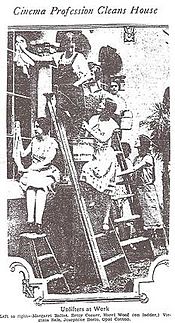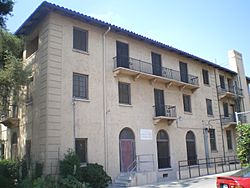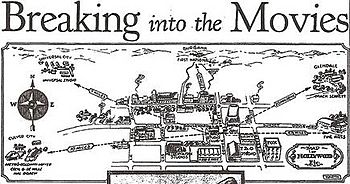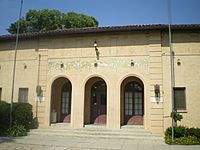Hollywood Studio Club facts for kids
|
Hollywood Studio Club
|
|

Hollywood Studio Club, May 2008
|
|
| Location | 1215–1233 Lodi Place, Hollywood, Los Angeles, California |
|---|---|
| Built | 1925 |
| Architect | Julia Morgan |
| Architectural style | Italian Renaissance Revival |
| NRHP reference No. | 80000806 |
Quick facts for kids Significant dates |
|
| Added to NRHP | November 25, 1980 |
The Hollywood Studio Club was a special home for young women who wanted to work in the movies. It was like a supervised dormitory or a sorority house. From 1916 to 1975, it helped thousands of young women in Hollywood, Los Angeles, California.
The YWCA ran the Studio Club. Over its 59 years, about 10,000 women lived there. Many famous people stayed at the club before they became stars. These included Marilyn Monroe, Ayn Rand, Donna Reed, Kim Novak, Maureen O'Sullivan, Rita Moreno, Barbara Eden, and Sharon Tate.
The building itself was designed by Julia Morgan. She was a famous architect who also designed Hearst Castle. The Studio Club building is in the Italian Renaissance Revival style. The club closed in 1975. The building was later used as a Job Corps dormitory until 2012. It was added to the National Register of Historic Places in 1979. Today, it is still owned by the YWCA Greater Los Angeles.
Contents
How the Studio Club Started
The Hollywood Studio Club began in 1916. It started when a group of young women, hoping to become movie stars, met in the basement of the Hollywood Public Library. They would read plays together. A librarian named Mrs. Eleanor Jones noticed that these young women often lived in cheap hotels. She worried they had no good place to study or practice their acting.
Mrs. Jones asked the local YWCA for help. They set up a meeting place for the women. Soon, Hollywood studios and business people donated money. This allowed them to rent an old house on Carlos Avenue. It had enough space for 20 women.
Important people like Mrs. Cecil B. DeMille and Mary Pickford helped run the club. Mary Pickford later said that Mrs. DeMille "spent every day doing something for the club." She also noted that the movie industry supported them. In 1919, a newspaper called the club "more of a sorority." It offered a "refining touch of home life and sense of protection." It also helped women financially when they needed it.
The "Studio Girl" Image
In the early 1920s, Hollywood faced some public scandals. This made the image of young women trying to make it in movies look bad. Many people thought these "extra girls" were often taken advantage of.
To fix this problem, Hollywood studios decided to make changes. Will H. Hays led these efforts. They created the Central Casting Bureau in 1925. This office helped manage actors and extras. They also built a large new home for the Hollywood Studio Club in 1926.
By opening a big, supervised home for young women, the studios hoped to change their image. They wanted to show the "new studio girl." This was a smart, graceful, and polite woman. She would learn good manners and performing arts skills. Will Hays told The New York Times that he wanted to make the movie business "a model industrial community." This included places for fun, community centers, and dorms with supervisors.
Building the Club
Between 1923 and 1925, there was a big effort to raise money for the new Hollywood Studio Club. Many movie studios gave money. For example, Famous Players-Lasky gave $10,000. Metro Goldwyn and Carl Laemmle each gave $5,000. Warner Bros. gave $3,000.
In March 1923, movie star Andree Peyre even did an airplane show over Hollywood to help raise money. In February 1925, a final $5,000 donation came from silent movie star Norma Talmadge. This allowed construction to begin.
The organization hired architect Julia Morgan to design the new building. A special ceremony to start construction happened in June 1925. Mary Pickford and Julia Morgan were both there.
The new Hollywood Studio Club opened in May 1926. It cost $250,000 to build. About 2,500 people attended the opening ceremony. Many movie stars were there. There were dedication ceremonies in the afternoon and dancing at midnight.
Julia Morgan designed the Studio Club in a Mediterranean style. The inside was decorated in colors like green, rose, and tan. The large building has three parts. There is a main section with wings on each side. The entrance has a loggia, which is like a covered porch with three archways. There is also a painted design above the main entrance.
The building has many features that Julia Morgan used in her other Mediterranean-style buildings. These include tall arched windows, balconies with iron railings, and decorative brackets. A writer in California Graphic magazine said the building was "one more jewel" for Hollywood. It showed the city's desire to support "every progressive endeavor."
The rooms at the Studio Club had special nameplates on their doors. These names were for people who donated at least $1,000 to the building fund. Rooms were named after stars like Douglas Fairbanks, Howard Hughes, Gloria Swanson, Jackie Coogan, and Harold Lloyd.
Life at the Club
To live at the Studio Club, a young woman only needed to be seeking a career in the movie business. This included actresses, singers, script girls, writers, designers, dancers, or secretaries. Many people called it a sorority.
The Studio Club offered classes in performing arts. It also hosted dances, teas, dinners, plays, fashion shows, and stunt nights. Residents received two meals a day. They also had access to sewing machines, hair dryers, laundry equipment, typewriters, and practice rooms. There was even a stage and a sundeck.
Rosemary Breckler, a former resident, remembered how dates would wait downstairs. She said, "dressed like princesses, we floated down those gorgeous stairs."
In 1946, a newspaper described the club as a "comfortable sorority house." It had "many of the freedoms and comforts of a man's club." By then, it had grown from a home for 22 girls to a home for 100 girls. Another 100 servicewomen also stayed in a nearby guest house.
In 1959, an article called the club a "colony" of students. It described the atmosphere: "You may hear the wail of a clarinet, the vocal exercise of a balladeer." It was a place where groups would talk about their day. They would share stories of looking for jobs, their good luck, or their challenges.
In 2000, Susan Spano wrote in the Los Angeles Times: "The handsome Italianate building... still evokes the good old days." She said it was a place where a mother could send her daughter to Hollywood to become a star without worrying.
Club Closure
By the mid-1960s, times had changed. The idea of a supervised dormitory seemed old-fashioned. In 1964, the club allowed more types of members. This included studio secretaries, dancers, and models. However, the club started losing money.
The YWCA Greater Los Angeles thought about using the building for offices or selling it. But residents started a petition to keep it open. By 1971, the club had to open its doors as a regular hotel for women. It also stopped serving meals. Still, it kept losing money.
Changes in fire safety rules also caused problems. It would cost about $60,000 to update the building. In 1975, the Studio Club closed its doors for good.
At the time, the Los Angeles Times wrote about the closure. It said the club was a "haven for all those young girls." Nearly 10,000 women had come there to seek fame. Some made it, most didn't. But while they were there, the club tried to be a "substitute home." Actress Dorothy Malone, who lived there in the 1940s, said, "It's out of vogue to live in a club atmosphere." She explained that men were not allowed in the rooms, and girls did not live with their boyfriends back then.
In 2018, the city of Los Angeles began using the building again. It became a home for women in need, with 64 beds.
Famous Residents
Over the years, many future stars lived at the Studio Club. Here are some of them:
- ZaSu Pitts – She was a star in the 1924 movie Greed. She was one of the first stars from the Studio Club. Pitts later said, "without the club I should have been a village dressmaker all my days."
- Ayn Rand – When Ayn Rand came to Hollywood in 1926 to be a screenwriter, she lived at the Studio Club. She was hired as an extra, earning $7.50 a day. She left the club early each day to be at the studio by 6 a.m. While there, she met Cecil B. DeMille and her future husband, Frank.
- Maureen O'Sullivan – She played Jane in the Tarzan movies of the 1930s and 1940s. Maureen O'Sullivan moved into the Studio Club when her mother brought her to Hollywood from Ireland.
- Virginia Sale – Sale had over 150 film and TV roles. She also started at the Studio Club. Years later, she remembered her friendship with Ayn Rand there. Rand encouraged Sale's writing. Sale said Rand "did the sound effects for me backstage." This is where Sale's one-woman show began.
- Diana Dill – Diana Dill was an actress living at the Studio Club. She met Kirk Douglas there, and they married in 1943.
- Marie Windsor – Known as "Queen of the B's" for her roles in film noir, Windsor won two beauty pageants before coming to Hollywood. She lived at the Studio Club for three years, which was the maximum stay. She even returned for six more months after World War II.
- Dorothy Malone – She won an Academy Award for her role in Written on the Wind. Malone lived in the Studio Club in the 1940s. She said, "You had to have references and a letter from your parents just to get in." She dated Mel Tormé while living there.
- Kim Novak – Kim Novak was a big star who lived at the Studio Club in the 1950s. When Harry Cohn, president of Columbia Pictures, signed her, he required her to live there. He even posted a studio guard outside the club. Novak moved in in 1953 and stayed even after becoming famous.
- Barbara Eden – In the 1950s, before her role on I Dream of Jeannie, Eden lived at the Studio Club. Other residents remembered that Eden would apply for every show business job she saw on the club's bulletin board.
- Joanne Worley – She became famous in Laugh In. Worley lived at the Studio Club in the 1960s. She remembered it as a "wonderful place." She said it was "inexpensive, had good food and 24-hour telephone service." She especially loved the "best coffee cake" on Sundays.
Other famous residents included:
- Donna Reed (star of It's A Wonderful Life and The Donna Reed Show)
- Rita Moreno (winner of an Academy Award, Grammy, and Tony Award)
- Linda Darnell (star of Forever Amber)
- Nancy Kwan (star of The World of Suzie Wong)
- Barbara Rush (Golden Globe winner for It Came from Outer Space)
- Janet Blair (movie star in the 1940s)
- Elvia Allman (voice of Clarabelle Cow and roles in I Love Lucy)
- Barbara Britton (star of Captain Kidd)
- Gale Storm (star of My Little Margie and The Gale Storm Show)
- Evelyn Keyes (Scarlet O'Hara's younger sister in Gone with the Wind)
- Ann B. Davis (two-time Emmy Award winner as "Schultzy" and Alice in The Brady Bunch)
- Sally Struthers (Gloria from All in the Family)
- Farrah Fawcett (star of Charlie's Angels).
A Historic Place
The Hollywood Studio Club is an important historic building. It has been recognized by both the city and the nation. In 1977, the City of Los Angeles named it a Historic-Cultural Monument. In 1980, it was added to the National Register of Historic Places.
In 1994, a TV show called Visiting... with Huell Howser featured the Hollywood Studio Club. The episode showed a tour of the building. It also included stories from several women who used to live there.
Images for kids










